A stark figure zaprudered on the roof of a church spawns a genre-busting, apocalyptic literary thriller.
By Mark Fenton
Published November 23, 2006
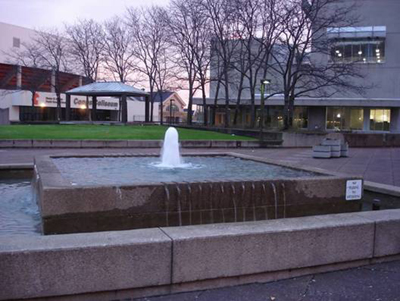
Jackson Square fountain
It is 7:30 am on a weekday late October and I am intrigued at why:
Readers of my May 5 essay on the Jackson Square rooftop will wonder why I am returning to this subject. It is six months almost to the day since I took this same path to get my teeth cleaned, which is also what I'm doing today. If this feels redundant I would remind readers that some concepts are rich enough to be extended into a sequel or even a trilogy. I'm thinking of Mad Max -
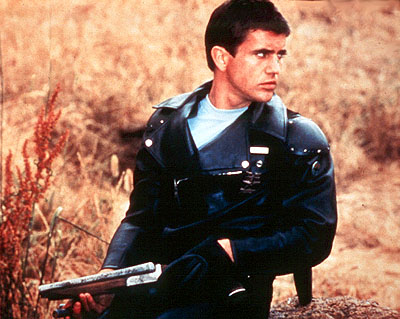
Mel Gibson in MGM's Mad Max, 1979
which was followed by The Road Warrior and Beyond Thunderdome, all of which met with generally favourable reviews. And no one complains that Monet painted Rouen Cathedral repeatedly from the same angle,
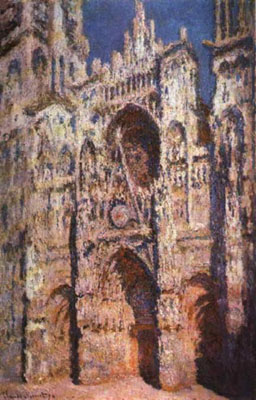
Rouen Cathedral: Full Sunlight, 1894; Louvre, Paris
simply at different times of the day, of the year, and under different kinds of light.
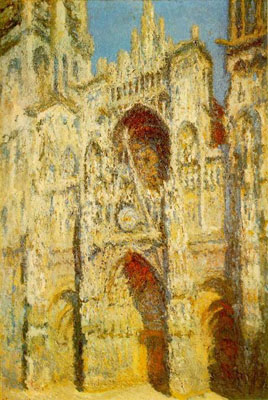
Rouen Cathedral, the West Portal and Saint-Romain Tower, Full Sunlight, Harmony in Blue and Gold 1994, Musee d'Orsay, Paris
On my way over the Jackson Square Rooftop (hereinafter referred to as the JSR) I always veer over to the King William Street view, which, set slightly at an angle to the stair, gives King William a dramatic presence, one which, for me personally, is more dramatic than the career of the eponymous monarch himself, important though the uncle to Queen Victoria was to British parliamentary reform.
Today King William is more dramatic than usual.
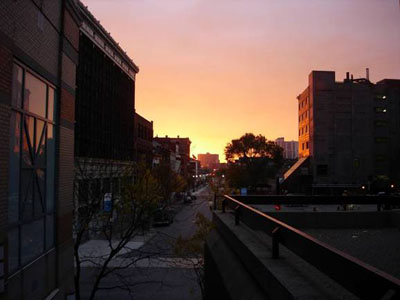
King William Street: more dramatic than usual
Maybe it's because I've never liked getting up early in the morning, but sunrise is a completely different experience than sunset. For me the very idea of a sunset always summons the clichéd image of the couple silhouetted against it on the beach. Sure enough, I Google silhouette beach sunset and in seconds I see a dozen such images each equal in expression and technical accomplishment. (Stock photo indeed!)

The silhouetted couple on the beach: always in stock
I don't possess information or knowledge of astronomy enough to swear that this is a sunset not a sunrise. However, one always assumes that by sunrise this couple is spent, and finally asleep following a night of passion, that they are not having a brief moment of tenderness before their early morning jog which prefaces their hellish two hour commute, opposite directions, each in his and her (possibly matching!) Mercedes SUV.
To return to my photo of King William, what strikes me most is the dark hulk of Lister Block on the left side of the image, its tenuous existence and its smashed windows speaking of the menace of semi-condemned buildings. While I'm sure it contains nothing more than some discarded pop cans and McDonalds wrappers, I, like everyone else I'm sure, imagine its dark cavities to be the home of transient sexual commerce and crystal meth labs.
Such a rot could spread quickly to the entire urban core. (Am I the only person who, when hearing the word "core" in this context, summons up an image of a brown apple core, overrun with ants, in advanced decay, thrown randomly into the debris of an alley behind a Payday Loans office? Well, am I?)
The redness of the morning puts me in mind of a lost art form: those impressionistic oil paintings which adorned pulp paperbacks of post-nuclear novels from the late fifties to early '70s, two of which I reproduce here. It was an art of specific techniques. Everything in these pictures is in a state of perpetual burning.
The sky itself is on fire (by contrast, I recall that the burning buildings of September 11, 2001 only accentuated the purity and blueness of the sky, but scientists reading this can verify whether or not such colours of sky will precede say, a nuclear winter).
I reproduce a couple of such book jackets here -
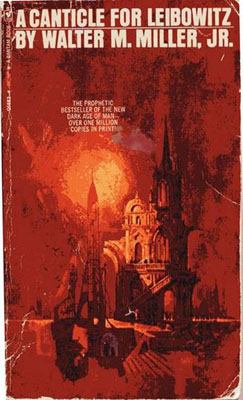
Walter M. Miller, Jr., A Canticle For Liebowitz, Bantam, 1959
partly because I like to imagine myself as the last man wandering through these landscapes in a cold war era suit with a JFK haircut -
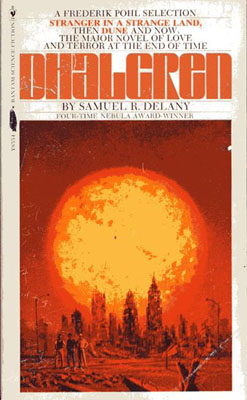
Samuel R. Delaney, Dhalgren, Bantam, 1975
and partly because I'm intrigued by how it took Monet's monochrome impressionism half a century to trickle down into paperback cover illustrations, but mostly because each of these books in its own way is a truly ass-kicking example of cold war era sci-fi, and I strongly recommend either of them, and they can be purchased in these very editions for about $2.00, at almost any used bookstore that stocks pulp sci-fi.
I retreated from the view of King William back on to the roof to get my bearings. I was now in danger of being late for my cleaning appointment, but caught up in a frolic of my own I barely cared. I noted a movement in my peripheral vision in the direction of the conjoined skyscrapers and photographed it without even knowing what I was capturing.
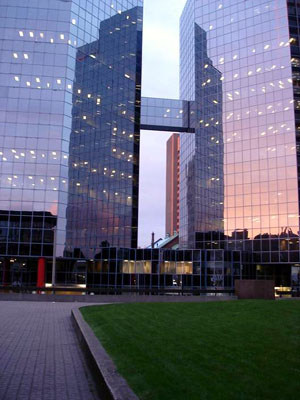
A peripheral movement
The wonders of the digital age! Unlike the photographer in Antonioni's Blowup -
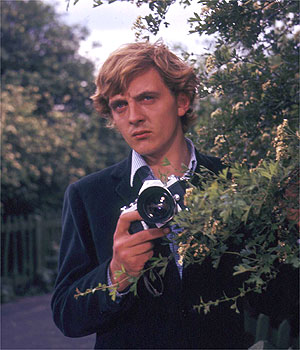
Blowup, Michelangelo Antonioni, 1966
who had to wait until he was back at the studio with his enlarger, I was able to zapruder the image as I stood on the JSR, to confirm that, sure enough, atop the church roof in the middle of the bottom third of my photograph stood a lone figure.
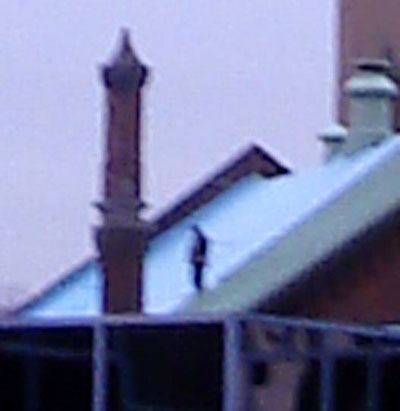
A lone figure on the roof
I was already contemplating the starkness of the figure. The posture suggests someone male, someone obviously at ease on rooftops, even steep ones, I thought as I rushed down the JSR stairs.
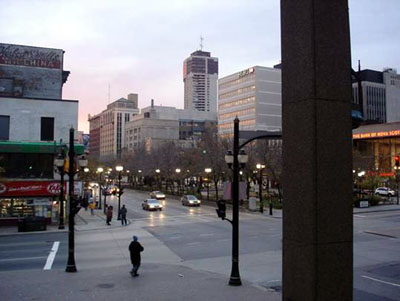
King and James, overlooking Gore Park
Of all the familiar denizens of city rooftops, most of whom are superheroes, I asked myself, who does this figure resemble more; Batman or Spiderman? I was already composing a mental essay on the dialectic of Batman and Spiderman.
Batman, poster boy for a right-wing shadow-government, sex-club leather cloaking a veiled pansexuality (Batwoman and Robin); hi-tech cars, gadgets, and operations obviously bankrolled by hidden money from a dark corner of the private sector; justice done at any cost [make that almost any cost: I have it on good authority that Batman refuses to kill his enemies - Ed.]; the players vague - people need to be helped, but they don't need to know how.
Spiderman, the no bullshit superhero; lo-fi, real day job in journalism (the lowest paying white collar job to be had); nimble, sleek, dressed like a bike courier (some athletic non-designer fabric, spandex I'd guess - it looks easily laundered); the cranky uncompensated reformer - "Don't worry about me! Want to see injustice? I'll show you injustice."
That's an essay I won't be writing. Not in this issue, anyway. For suddenly I know who this dark, slouching figure reminds me of:
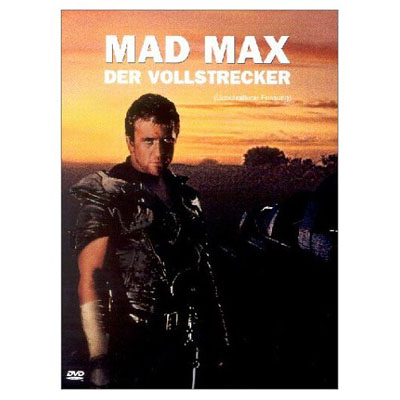
Mad Max 2/The Road Warrior 1981
That's right: Mad Max, the Road Warrior, the young Mel Gibson. I will ponder him further as I get my teeth cleaned. (By the way, what's with the German, considering I pulled this off of the English-language Amazon.com page for the DVD? It gives it a Teutonic power I find appropriate. Like maybe there's a Rammstein song on the soundtrack.)
Now, some people have found Gore Park a bit challenged as a public space. I, however, have loved it since I first laid eyes on it when I moved here in 1990.
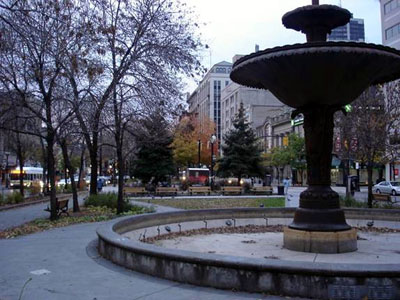
Gore Park
I will admit that I didn't immediately identify it as a park, but rather as a lavishly decorated median, bookended by a statue of John A. McDonald (inquisitive, myopic, left foot forward but hesitant, brave but uncertain of the future) and a statue of Queen Victoria, one block South of her Uncle's street (stern, eternal, more certain of everything than John A. will ever be of anything).
I always make the effort of crossing the street and walking through (along?) it when I pass through that section of King Street, and I lament that my life has become too busy to sit and gaze for hours at the slow acrobatics of window cleaners pulling themselves up and down high-rises. It is probably regressive and unsustainable and pre-9/11 of me, but I find the act of keeping big public objects shiny an endlessly compelling and noble thing on which to cast my gaze.
I also like the Gore Park fountain, which as you can see isn't operational at this time but for me, even in an arid state, is more impressive than the one which opens this article, erupting its bullet shaped nub into dawn on the JSR.
As you can see, Gore Park is thinly populated at this time of day and pigeons are pecking. I startle a bunch of them on my walk, and like any dork new to photography I take a pointless photo of the birds wheeling around the fountain, one that I momentarily believe will be kinetic and redolent of the persistence of nature within the built environment.
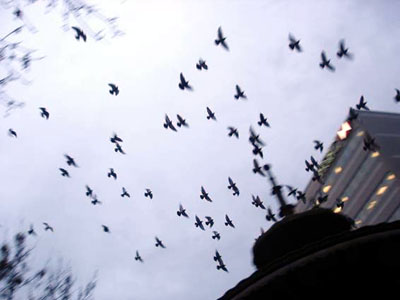
Pigeons wheel over the fountain
It isn't kinetic or redolent of the persistence of nature within the built environment. It is pretentious, stock and out of focus. I toyed briefly with the idea of salvaging the image by quoting a stanza from W.B. Yeats from one of those poems where he equates birds spiraling upwards as a foreshadowing of the apocalypse, e.g.
All suddenly mount
And scatter wheeling in great broken rings
Upon their clamorous wings.
--from "The Wild Swans at Coole"
I thankfully remember that these are swans Yeats is talking about, not pigeons. I also remember an essay by James Thurber in which he argues against investing pigeons with any emotional or symbolic resonance whatsoever, taking as his jumping-off point Gertrude Stein's admittedly baffling observation: "Pigeons on the Grass, alas," and winding himself up into a strangely impassioned refutation of Stein, and a rant about the pointlessness of pigeons.
It is neither just nor accurate to connect the word alas with pigeons. Pigeons are definitely not alas…People who do not understand pigeons - and pigeons can be understood only when you understand that there is nothing to understand about them - should not go around describing pigeons or the effect of pigeons. Pigeons come closer to a zero of impingement than any other birds... When it comes to emotion, a fish, compared to a Pigeon, is practically beside himself.
--James Thurber, from "There's an Owl in My Room"
The essay goes on for about three pages and really doesn't develop much from his original premise, and I have to question why Thurber spilled this amount of ink on an animal he over-condemns as pointless. Isn't, for instance, the pigeon's capacity for "homing" worthy of some admiration? Thurber ignores this skill, and if he weren't dead I'd hit his website and probe him on his pigeon issues and evasions.
I am almost running now and before I know it, like a scene from the Alice in Wonderland where Alice suddenly accelerates so rapidly she can't remember how she covered such a huge distance, I am in the elevator that ascends to my dentist.

Dentist's office, floor 11
The office isn't hard to find, but I note that all the dentists on this floor appear to be in office #1111.
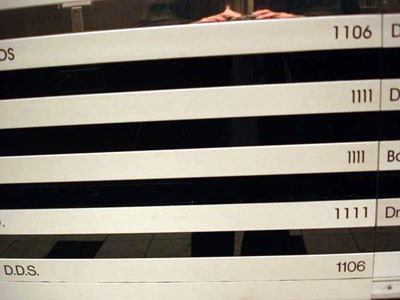
Three dentists, three specialties?
All those number "1"s are uniform, serrated and very, very dental. They are, however, given varied spacings for each particular dentist. One assumes that each has his specialty. The first specializing in normally spaced teeth, the second specializing in crowded teeth, and, you guessed it, the third specializing in widely spaced teeth. That's how I read it.
Late though I am, I am asked to linger a minute, in the waiting room, with tropical fish:
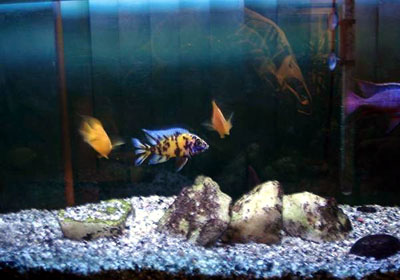
Tropical fish: proven to soothe the jittery nerves of dental patients
For my moneny, they are not positively beside themselves, even compared to the pigeons, which confirms for me that Thurber had deep seated anxieties around pigeons. It may have something to do with pigeons being - other than the odd rat in the subway - the only wild animal an urban New Yorker ever sees.
I am taken to the cleaning room. I am due for an X-ray, and when the hygienist goes out to take it I am able to get a few shots of the artwork.
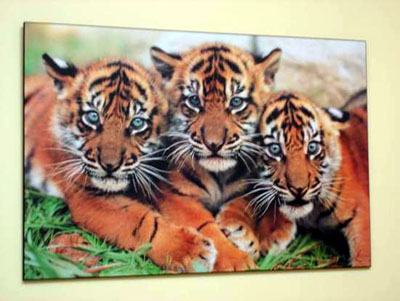
Three poster children for good dental hygeine
This second shot is a bit blurred because as the hygeinist was coming back in I still had my camera out and she sort of unnerved me.
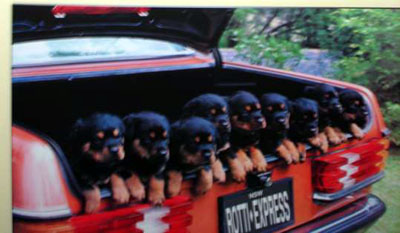
Fascist rottweiler puppies?
She didn't actually say, "Um, is everything OK?" but I felt it was implied by her look. I said something like, "I think my daughters would love this room so I wanted to get them some pictures."
To which she answered, "I know, it's my favourite room too." [?!]
The implications of the pictures are straightforward and ruthlessly Darwinist. The very fact that these animals are concealing their teeth only amplifies the arrogance of animals near or at the top of the food chain. The message is simple: Nurture your teeth and you will conquer, neglect them and you will die, and your DNA will not be carried into the future.
There is something specifically fascistic about the picture of the dogs. The picture says this to me: Winners have good teeth. Good teeth open doors, so that winners can prosper and afford a car with a big trunk. From the truck of this car may spring a litter of purebred Rottweilers, a breed strong and obedient and martial; a breed that winners have dominion over; a gang of which they can mold from birth to protect and to serve them. Be a winner. Get your teeth cleaned twice a year!
My mind starts free-associating. I don't much care for having my teeth scraped and try to put myself into a trance like state, just conscious enough that I won't have to be woken up every time the hygienist asks me to open my mouth a bit wider. Even in my reclining position there is no escaping the gaze of the tigers.

There is no escaping the gaze of the tigers
The tigers won't let me be, I think, and wonder why this sentiment is so familiar. I realize it is from a very sad Charles Bukowski poem, one he wrote for a dead lover.
For Jane
225 days under grass
and you know more than I.
they have long taken your blood,
you are a dry stick in a basket.
is this how it works?
in this room
the hours of love
still make shadows.when you left
you took almost
everything.
I kneel in the nights
before tigers
that will not let me be.what you were
will not happen again.
the tigers have found me
and I do not care.--Charles Bukowski
It is difficult, lying in an almost inverted position having your teeth scraped and having that tubular vacuum thing hanging out of your mouth - the one that sucks saliva and blood out - to explain to a hygienist that your eyes are tearing up not from inadvertent pain she's causing (which both she and you know wouldn't be painful if you flossed as regularly and correctly as you've been instructed), but rather from running the lines of a sad poem through your head, the memory of which was triggered by the artwork in the room, which she has already witnessed you being simple-minded enough to have been photographing obviously as entranced by it as the six-year-olds for which it was intended.
I figure it's easier to let her assume it's my gums that are causing my pain (which are weathering the cleaning fairly well so far, way to go, Mark, you really are attending to oral hygiene better as you age) and that I'm just a big baby.
I close my eyes and get that weird effect where under bright light you see abstract shapes through your eyelids which can seem to become recognizable images:
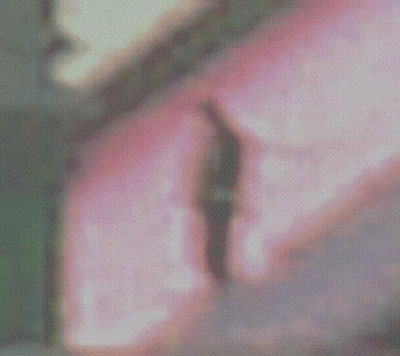
The figure on the roof
So I'm back thinking about that figure on the roof, although I've now formed a new idea for the Road Warrior, one in which the trope isn't the shortage of fossil fuels, but rather the shortage of safe elevations.
Through some horrible genetic terrorism, a race of super tigers have begun to multiply, and what's worse, with the advent of global warming, tigers are now spread throughout the earth's surface, because winters aren't a problem for them now, even in Canada.
Most of the people have been eaten, but a small colony is living atop the roof of an inner city mall (a bit like the JSR, although obviously not with the stairways, which tigers could get up sooo easily.) OK, these mall-roof people are the good guys and the bad guys want to get onto it because the roof dwellers are able to live off of all the food-like substances that still exist actually in the mall's food court.
This stuff is all that's left a few years on from when the white light flashed and all the clocks stopped and all the standard events of the end-of-the-world-as-we-know-it movies happened. The edibles in the food courts haven't really gone bad because they aren't really food. That's why everyone wants to take over the roof of a mall, the bad guys particularly. So when the lone roof warrior comes by everyone just thinks he's a bad guy.
As the film opens he's shown dramatically, at sunrise, on the roof of Lister Block, which is cinematically the perfect location. He's not really interested in the good guys or their rooftop; he just wants enough supplies to get to the rooftops on the other side of the city, maybe reheat a few gyros and pizza slices to take with him and move on. He can't get there without crossing the mall.
Here's his deal: he can have a Sportcheck backpack full of several bags of McDonalds fries and an extra large Coke provided he's prepared to rescue a big cache of frozen hamburger patties from the mall's sub-basement. The problem is, the tigers are guarding it. They can't get through door locks, but they're smart enough to wait for someone to come along and open the metal gate protecting it.
I don't want to spoil it by describing the climactic scenes, but in the end the good guys move to another mall through a system of pulleys and climbing gear and with all their pseudo-meat and the roof warrior diverts the bad guys onto the wrong mall, one of those late '80s malls where they actually kept wild animals in cages and now the animals have got out and onto the roof and are REALLY hungry and mutated and more deadly than the tigers. The Roof Warrior himself is last seen back on a roof, against a sunset:
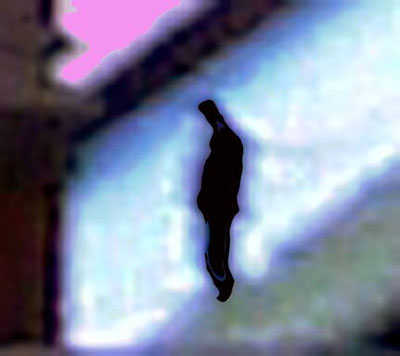
The Roof Warrior redux
We hear the voiceover: My life fades. The vision dims. All that remains are memories. I remember a time of chaos. Ruined dreams. This wasted land. But most of all, I remember ... The Roof Warrior.
"Ouch!"
"Sorry. I said to close slightly."
"I, uh, I must not have heard."
The hygienist's face was a little behind what I could see, but I'm sure she rolled her eyes.
I closed my eyes again and managed to get back into my special place. Not surprisingly, my mind wandered from The Road Warrior to a famous film version of Hamlet.
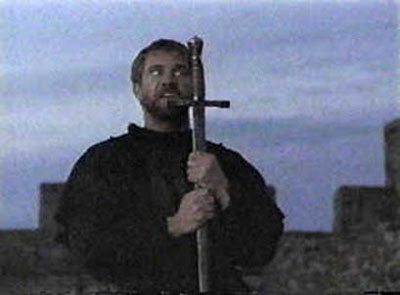
Hamlet, Franco Zeffirelli, 1990
Hamlet is the son of a dentist and both the dentist and his brother own the practice in which Hamlet is supposed someday to be working (right now Hamlet is just taking time off to find himself and deal with some issues).
Just before the play starts, Hamlet's Dad is found mysteriously dead from an OD of laughing gas. Now his Uncle is the sole owner of the practice and Gertrude, Hamlet's Mom, is getting free dental work whenever she wants it. Her teeth are filled, root canalled, capped, whitened, you name it. Claudius does it all for free.
Interesting, thinks Hamlet. She's got gorgeous teeth now, movie-star perfect. Hamlet has a young girlfriend named Ophelia. She's not notably intellectual, except that she's undeniably sophisticated around orthodontia and periodontia, even though she's only 17 and still has her retainer. She gets her orthodontic work done by Polonius & Associates, her Dad's orthodontic practice.
She hangs out with oral surgery students, the way, say, the daughter of a rock musician might hang out with indie bands. So even though any young man on the dental scene would kill to have Ophelia as a girlfriend, Hamlet just treats her like plaque.
It's never actually stated but Hamlet and Ophelia take this attitude that dentistry is a sort of low-brow occupation, and that orthodontia is where the oral intelligentsia is really at. Hamlet's snotty about it to Claudius in a manipulative way. See, he's really using his apparent disdain for mere dentistry - playing off of Claudius's insecurities - to break down Claudius's façade and reveal Claudius as Hamlet's father's murderer. ("And thus by indirections find directions out" is the one quote from the original I'm half-tempted to leave in.)
Hamlet's learned that confronting his Mom on this mystery is useless, since whenever Hamlet talks to her she just goes wide-eyed and giggles like a teen-ager showing a guy she thinks he's smart and funny by laughing randomly and showing off her beautiful smile, and this behaviour imposes neuroses on Hamlet that Hamlet just doesn't need.
Hamlet, of course, is really a frustrated artist, for whom the dental world is just his palette. Ophelia's brother Laertes is studying to be an oral surgeon somewhere in Germany, and Hamlet enlists Laertes to help produce a video on degenerative oral diseases (The Mouth-Trap).
This video is cutting edge in the sphere of medical videography, lots of handhelds, all location shooting and sound mix all done during shooting: "This is going to be the first medical documentary to get Dogme '95 certification," says Hamlet, only half ironically. (This is Denmark, after all.)
Here's the plan. Hamlet flatters Claudius by telling him he's so knowledgeable about dentistry that he should be the head of a panel to answer questions on The Mouth-Trap to a group of interns with which Laertes is studying. Flattery will get you places with guilt ridden, power hungry dentists, and Claudius agrees.
After the screening, which has a long section on the risks of laughing gas, during which Hamlet stares fixedly at Claudius and watches him squirm, the oral surgery interns - and let me tell you, these German kids know their stuff - pepper Claudius with questions full of new vocabulary he simply doesn't know.
When he's really befuddled Hamlet looks him straight in the eye and says, "So alright then. Oral surgery isn't your bag, but can you give a medical opinion on the risk of fatality from laughing gas!" Claudius runs screaming from the room and Hamlet chases him with a dental drill as far as the cord will reach.
You get the idea. It otherwise follows the original fairly closely. Polonius drowns in a vat of tooth molding clay that Hamlet had meant for Claudius.
I didn't quite know what to do with Rosencrantz and Guildenstern. I've temporarily made them bike couriers who, thanks to Hamlet's reprogramming of their GPS, get eaten by tigers bounding forth from the ruins of Lister Block on the way to deliver some X-rays to Polonius & Associates, although I'll admit I'm not entirely happy with this detail.
Oh, one thing I'm fairly pleased with is where Claudius tries to distract Hamlet from the murder plot by sending Hamlet to work as cameraman on a goth punk video Gertrude is in and perfect for now she's got the blackest of black hair and whitest of white dentally enhanced teeth, and they're shooting in a graveyard where Hamlet comes across the skull of Yorick, his childhood dentist (flashback to office adorned with cute tiger cubs, rottweiller pups, etc.) a happy-go-lucky fellow who was great with kids and inspired Hamlet to embrace the family profession.
Hamlet meditates on Yorick in a 32 line soliloquy and is able to identify it as Yorick's skull by surfing into Yorick's dental records on his Blackberry. (I never understood why Hamlet was so sure that skull was Yorick's. My version - not Bill's - my version solves this problem.)
When my cleaning was all done I made some remark to the hygienist that she must be really good at what she does, as it didn't hurt very much at all. She smiled in a way that said she didn't altogether believe me but that it was an appropriate enough pleasantry at the end of teeth cleaning.
As she left to take my file up to reception I snapped this last photo, hoping to get a good picture of dental gear but hitting the jackpot and even getting a shot of my teeth!
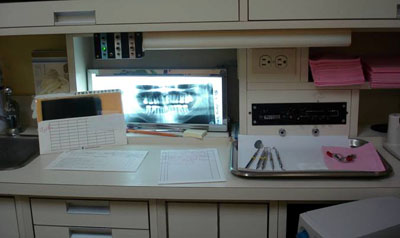
A shot of Mark's teeth
I recently visited an orthodontist to consult about the possibility of braces for my daughters, and their teeth were lavishly displayed on an elegant flat-screen computer monitor, and as they have more teeth at this point in their lives than I've managed to retain, theirs would have made a better final photo, what with the dynamic between last remaining primary teeth, and permanent teeth pushing them into oblivion, which is stunning on a purely aesthetic level, but I didn't think it appropriate to take a photo of them.
It's one thing to strip yourself bare to the bone in RTH, and an entirely other thing to exploit your daughters in such a way. (For me the failure to respect these sorts of boundaries is what's rotten at the core of Hamlet's family, although, sure, there are lots of other valid interpretations to the play.)
For a moment I wondered if these teeth were even mine, if they were instead teeth left illuminated from a previous patient, and I would have qualms about displaying the X-rays of a stranger, but I can see quite clearly Mark Fenton 05 handwritten on the right hand side.
By the way - since it's out there now - I've had a dozen medical opinions about whether I should have that last remaining top wisdom tooth out, so any of you who want to write in (oral surgeons, dentists, hygienists, bike couriers, I'm not a snob) feel free to offer your advice.
In any case, to those who've remarked that these photo-essays consistently lack an author photo, this and the reflection of my vampirish hands in the 11th floor office directory photo (see above; bet you missed it the first time) should more than suffice.
By jerk (anonymous) | Posted June 24, 2011 at 16:23:33
A Canticle for Leibowitz, not Liebowitz (see cover)
Samuel R. Delany, not Dalaney (see cover)
By jerk (anonymous) | Posted June 24, 2011 at 16:24:19
A Canticle for Leibowitz, not Liebowitz (see cover)
Samuel R. Delany, not Delaney (see cover)
You must be logged in to comment.
There are no upcoming events right now.
Why not post one?